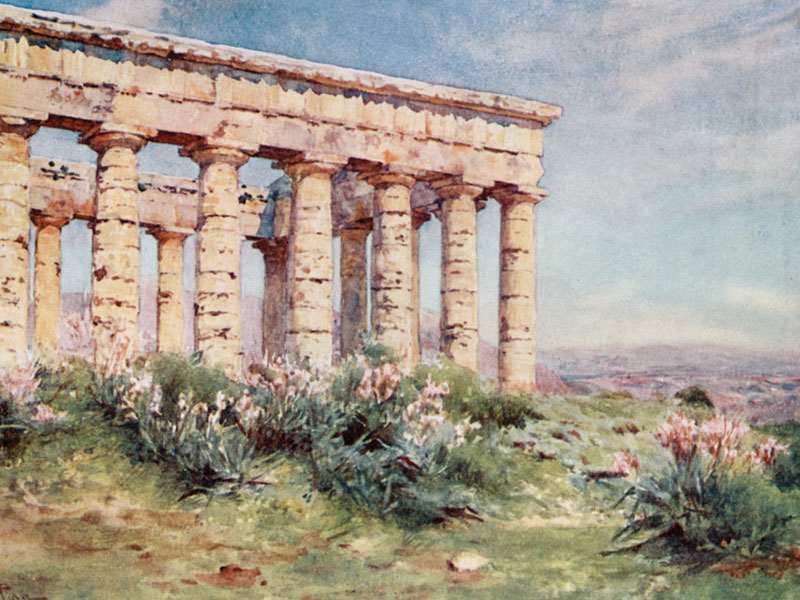Overview
Sicily is the pre-eminent island in the Mediterranean – the largest as well as the most eventful historically. It is also more or less in the middle, a stepping stone between Europe and Africa and a refuge between the Levant and the Atlantic. Throughout history Sicily was viewed as a fortuitous landfall by migrating peoples and a prized possession by ambitious adventurers and expansionist princes. And as the Mediterranean has been the catalyst and disseminator of a greater variety of civilisations than any other of the world’s seas, the island has accumulated an exceptionally rich and incomparably varied inventory of art, architecture and archaeological remains.
Here are to be found some of the finest surviving ancient Greek temples and theatres; Roman floor mosaics which have no peer in Europe; and wall and vault mosaics by Byzantine craftsmen which are unequalled anywhere. Medieval churches and Baroque palaces abound, and there are many memorable paintings, sculptures and other works of art.
As much part of the experience as these masterpieces are the picturesque hill towns, coastal settlements lapped by a gentle sea, haphazard alleys and vibrant city boulevards ornamented with wrought-iron balconies.
In every town there are buildings of unexpected magnificence and a plenitude of modest structures of ineffable charm. Some are well preserved, some are crumbling – witness to a deeper malaise.
For much of its history, Sicily was regularly one of the most prosperous of European territories, but political mismanagement and social dislocation led to a long, deep slump. Into the space vacated by absentee landlords and self-serving authorities, the ‘Honoured Society’ inserted itself as protector – though it has been even more exploitative and malign than the worst of earlier tyrants. And the region remains low in the tables of prosperity.
Matters are improving, however. Conservation and curatorship have made great strides in recent years, the Mafia has lost its dominance, poverty has lessened, and other indicators of wellbeing – the high quality of cuisine among them – are more evident as each year goes by. Sicily has been a part of a unified Italy since 1861 and ethnically and culturally it is unmistakably Italian. But it is also distinctly Sicilian, a world apart. Forming the backdrop to all this are some ineluctable landscapes, the formidable stark hills of the interior and the glittering greens of intensely farmed valleys. The smoking bulk of Mount Etna, Europe’s largest active volcano, is visible from much of the eastern part of the island.
Day 1
2024
Palermo. In April: fly at c. 11.00am from London City to Palermo, via Rome. In May: fly at c. 10.30am from London City to Palermo, via Milan. In September: fly at c. 7.45am from London City to Palermo, via Milan. (All flights are with ITA Airways.) The largest and by far the most interesting city on the island, Palermo has been capital of Sicily since the period of Saracenic occupation in the ninth century. It reached a peak under the Normans and again during the Age of Baroque. First of six nights in Palermo.
2025
Palermo. Fly at c. 9.00am from London Gatwick to Palermo, via Barcelona (Vueling). The largest and by far the most interesting city on the island, Palermo has been capital of Sicily since the period of Saracenic occupation in the ninth century. It reached a peak under the Normans and again during the Age of Baroque. First of six nights in Palermo.
Day 2
Palermo. A morning walk through the old centre includes visits to the Palazzo Abatellis and outstanding Norman buildings including La Martorana with fine mosaics. Lunch is at a private palace, by special arrangement. In the afternoon see the remarkable Greek sculpture in the Archaeological Museum. In the evening there is an out-of-hours visit to the Palatine Chapel in the palace of the Norman kings. Entirely encrusted with Byzantine mosaics, this is perhaps the finest assembly of Byzantine art to survive anywhere.
Day 3
Monreale, Cefalù. The small town of Monreale dominates a verdant valley southwest of Palermo. Its cathedral is one of the finest Norman churches on the island and possesses the largest scheme of Byzantine mosaic decoration in existence. Cefalù, a charming coastal town, has another massive Norman cathedral, also with outstanding mosaics, and an art gallery with a painting by the 15th-century artist Antonello da Messina.
Day 4
Agrigento. The remains of the Greek colony of Akragas at modern-day Agrigento constitute one of the greatest sites bequeathed by the ancient world. A relatively late foundation (580 bc), it rose rapidly to riches and constructed eight peripteral temples, the most numerous group in the Greek world. That dedicated to Olympian Zeus was the largest of all Doric temples before being felled by Carthaginians and earthquakes, while the Temple ‘of Concord’ is the best preserved.
Day 5
Segesta, Selinunte. Set in an unspoilt hilly landscape, the almost complete but fascinatingly unfinished fifth-century temple at Segesta was built by indigenous, if thoroughly Hellenised, Sicilians. On an adjacent hill is a spectacularly sited theatre with views to the sea. Selinunte, founded by Greeks from the Attic city of Megara c. 650 bc, is a vast archaeological site, renowned for its many temples and acropolis.
Day 6
Palermo. Start with the cathedral, a building of many periods (though largely medieval), with grand royal and imperial tombs, then to San Giovanni degli Eremiti, a Norman church with tall cupolas and a charming garden. See also Il Gesù, grandest of Palermo’s Baroque interiors. Optional visit to three tiny stuccoed oratories in the afternoon, or free time.
Day 7
Palermo, Piazza Armerina. Visit Castello della Zisa, an Arab-Norman Palace. Then leave Palermo and drive through the hilly interior of Sicily. At Piazza Armerina are the remains of one of the finest villas of the late-Roman Empire, whose floor mosaics comprise the most vital and colourful manifestation of Roman figurative art in Europe. Continue to the east coast for the first of three nights in Taormina.
Day 8
Taormina. Free day in this extremely pretty town. The Teatro Greco (actually largely Roman) is incomparably sited with far-reaching views encompassing smouldering Mount Etna, the Ionian sea and the Calabrian coast of mainland Italy. The town itself, clinging to a hillside with beaches far below, has buildings from five centuries as well as further Roman structures. A smart resort since the 19th century, our hotel has shaded gardens which spill down a series of terraces. (Also a swimming pool which is usually open between March and October).
Day 9
Messina, Reggio di Calabria. Drive along the coast to Messina. The city was one of Caravaggio’s Sicilian refuges, and in the art gallery there are two paintings by him and the best-surviving work by the 15th-century painter Antonello da Messina. Cross the Straits of Messina by hydrofoil to Reggio di Calabria on mainland Italy to see the Riace Bronzes, over-life-size male nudes associated with Phidias and Polyclitus, among the finest Greek sculpture to survive.
Day 10
Catania, Siracusa. Sicily’s second city, Catania was largely rebuilt after the earthquake of 1693 with long straight streets lined with Baroque palaces. Special arrangements to see a magnificent private palazzo and a Byzantine chapel, and visits to the Roman theatre and Normano-Baroque Cathedral. Continue to Syracuse for the first of three nights.
Day 11
2024
Noto, Siracusa. Rebuilt after the 1693 earthquake, the hill town of Noto is one of the loveliest and most homogenous Baroque towns in Italy. All of honey-coloured stone, vistas are enlivened with carved stone balconies with elaborate ironwork. Visit the convent of Santa Chiara, the cathedral and San Carlo. Return to Syracuse in the afternoon via the Archaeological Park and its famous Greek theatre, the largest of its type to survive.
2025
Siracusa. Morning visit to the mainland to Santa Lucia al Sepolcro, the church for which Caravaggio painted the Burial of Saint Lucy. Continue to the Archaeological Museum, organised thematically to bring together material from much of Magna Graecia. The afternoon is free.
Day 12
2024
Siracusa. Morning visit to the mainland to Santa Lucia al Sepolcro, the church for which Caravaggio painted the Burial of Saint Lucy. Continue to the Archaeological Museum, organised thematically to bring together material from much of Magna Graecia. The afternoon is free.
2025
Noto, Siracusa. Rebuilt after the 1693 earthquake, the hill town of Noto is one of the loveliest and most homogenous Baroque towns in Italy. All of honey-coloured stone, vistas are enlivened with carved stone balconies with elaborate ironwork. Visit the convent of Santa Chiara, the cathedral and San Carlo. Return to Syracuse in the afternoon via the Archaeological Park and its famous Greek theatre, the largest of its type to survive.
Day 13
2024
Siracusa. Situated at the southernmost tip of the island of Ortygia, guarding the entrance to the ‘Great Harbour’, the Castello Maniace is one of the great architectura statements of 13th-century Europe. See the Antonello da Messina’s bewitching Annunciation in the nearby Palazzo Bellomo. In April: fly from Catania, via Milan, arriving London City at c. 6.30pm. In May: fly from Catania, arriving London Gatwick at c. 1.45pm. In September: fly from Catania, arriving London Gatwick at c. 1.45pm.
2025
Siracusa. Situated at the southernmost tip of the island of Ortygia, guarding the entrance to the ‘Great Harbour’, the Castello Maniace is one of the great architectura statements of 13th-century Europe. See the Antonello da Messina’s bewitching Annunciation in the nearby Palazzo Bellomo. Fly from Catania, via Barcelona, arriving London Gatwick at c. 7.30pm (Vueling).
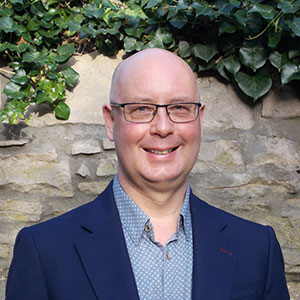
Dr Mark Grahame
Archaeologist, lecturer and Member of the Chartered Institute of Archaeologists (MCIfA). He obtained his PhD from Southampton University and his thesis on the spatial layouts of the houses of Roman Pompeii was published as a British Archaeological Report and a series of journal articles. He has coordinated an adult education programme in archaeology at the University of Southampton (2002–2011) and has taught courses on the archaeology and history of the Roman Empire for Cambridge and Oxford Universities' Institutes of Continuing Education. He is currently the director of the heritage consultancy, M-Arc Heritage Ltd., a company which he founded in 2018. Twitter: @RomanAgent
Dr Luca Leoncini
Art historian specialising in 15th-century Italian painting. His first degree and PhD were from Rome University followed by research at the Warburg Institute in London. He has published articles on the classical tradition in Italian art of the 15th century and contributed to the Macmillan Dictionary of Art. He has also written on Mantegna and Renaissance drawings. Instagram: @lucaleonci
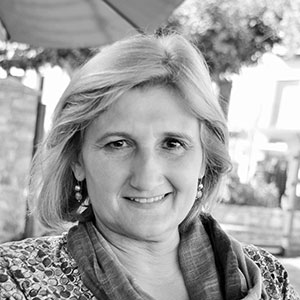
Dr Philippa Joseph
An art, architectural, and design historian whose research covers artistic and cultural exchange across Europe, especially between Andalucía and Sicily, and the wider Mediterranean basin. Philippa also has an academic interest in, and teaches on, 20th-century Italian architecture and design, about which she is currently writing a book for Reaktion Books. She is a Senior Fellow at the Institute of Historical Research, a tutor at the Oxford University Department for Continuing Education, and is a member of the editorial advisory board for History Today.
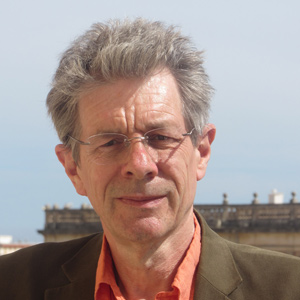
John McNeill
Specialist in the Middle Ages and Renaissance – lectures for Oxford University’s Department of Continuing Education. He is Honorary Secretary of the British Archaeological Association, for whom he has edited and contributed to collections of essays on medieval cloisters, chantries, Anjou, and King’s Lynn and the Fens. In 2010 he established a biennial series of international conferences on Romanesque visual culture. His most recent effort in this field – Romanesque Saints, Shrines, and Pilgrimage – was published in 2020. He is also author of the Blue Guides to both Normandy and the Loire Valley.
Price, per person
2024
Two sharing: £5,940 or £5,690 without flights. Single occupancy: £6,980 or £6,730 without flights.
2025
Two sharing: £6,430 or £6,020 without flights. Single occupancy: £7,730 or £7,320 without flights
Included
2024
Flights (economy class) with ITA Airways (and with EasyJet for the May departure); travel by private coach throughout; hotel accommodation as described below; breakfasts; 5 lunches (including 1 picnic) and 7 dinners with wine, water, coffee; all admissions; all tips; all taxes; the services of the lecturer and tour manager.
2025
Flights (economy class) with Vueling; travel by private coach throughout; hotel accommodation as described below; breakfasts; 5 lunches (including 1 picnic) and 7 dinners with wine, water, coffee; all admissions; all tips; all taxes; the services of the lecturer and tour manager.
Accommodation
2024
Grand Hotel Piazza Borsa, Palermo: centrally located 4-star hotel housed in an assortment of historical buildings. Hotel Villa Belvedere, Taormina: charming 4-star family-run hotel in the old town, with its own garden (rooms vary in size and outlook). Algilà Ortiga Charme Hotel, Syracuse: charming seafront 4-star hotel on the island of Ortygia. Single rooms are doubles for sole use throughout.
2025
Grand Hotel Et Des Palmes, Palermo (March): elegant 5-star hotel within walking distance of the city centre. Grand Hotel Piazza Borsa, Palermo (April, October): centrally located 4-star hotel housed in an assortment of historical buildings. Hotel Villa Belvedere, Taormina: charming 4-star family-run hotel in the old town, with its own garden (rooms vary in size and outlook). Algilà Ortiga Charme Hotel, Syracuse: seafront 4-star hotel on the island of Ortygia. Single rooms are doubles for sole use throughout.
Flights
As flights are not yet available to book for all of 2025, we have listed the most likely flights based on equivalent dates this year, but changes are possible. Direct flights are not regular, and indirect routes are subject to frequent changes. If you intend to book your own flights to coincide with our arrival and departure, we recommend you book flexible fares.
How strenuous?
This tour involves a lot of walking, some of it over rough ground at archaeological sites and cobbled or uneven paving in town centres. Fitness and sure-footedness are essential. There are also some long coach journeys. Average distance by coach per day: 73 miles.
Are you fit enough to join the tour?
Group size
Between 10 and 22 participants.
Travel advice
Before booking, please refer to the FCDO website to ensure you are happy with the travel advice for the destination(s) you are visiting.
Combine with
In April 2024:
Normans in the South, 19–27 March 2024
William Howard & The Carducci String Quartet, 19–21 April 2024
Genoa & Turin, 20–26 April 2024
Venetian Palaces, 26 March–30 April 2024
Pompeii & Herculaneum, 15–20 April & 23–28 September 2024
Gardens & Villas of the Italian Lakes, 18–24 April 2024
Samarkand & Silk Road Cities, 18–30 April 2024
Albania: Crossroads of Antiquity, 17–26 April 2024
Samarkand & Silk Road Cities, 18–30 April 2024
Western Andalucía, 22–29 April 2024
Cornish Houses and Gardens, 23 April–1 May 2024
The Cathedrals of England, 24 April–2 May 2024
Tom Abbott’s Berlin, 25–29 April 2024
In May 2024:
Medieval Heart of Portugal, 19–26 May
Friuli-Venezia Giulia, 20–25 May
Great Swedish Houses, 20–26 May
Versailles: Seat of the Sun King, 24–27 May
The Road to Santiago, 24 May–5 June
In September 2024:
Maritime England, 27 August–2 September
The Hanseatic League, 29 August–5 September
Connoisseur's Prague, 2–8 September
Pompeii and Herculaneum, 23–28 September
Raphael, in celebration, 23–29 Septemer
Granada & Córdoba, 23–30 September
Arts & Crafts in the Cotswolds, 24–28 September
Belgian Modern Masters, 25–29 September
The Cathedrals of England, 25 September–3 October
Bulgaria, 28 September–7 October
In November 2024:
Ancient and Islamic Tunisia, 2–9 November
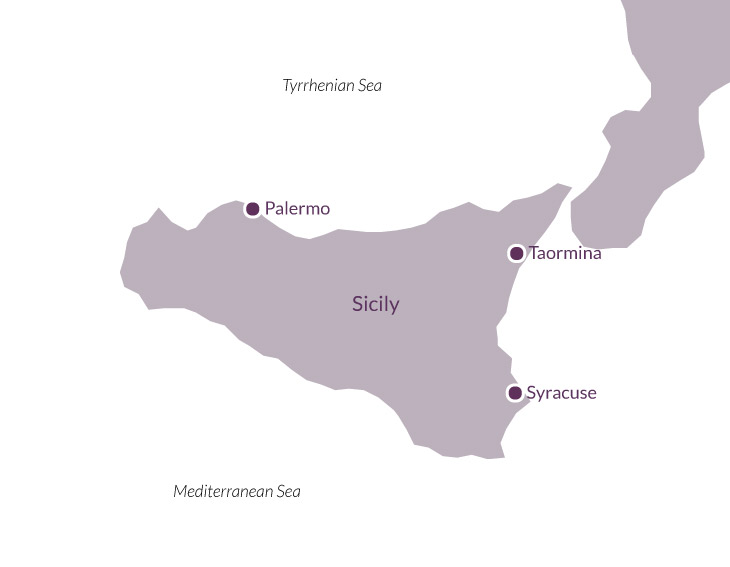
'A superb introduction to Sicily. Very well thought out.'
'Overall a well-balanced mix which brought together the disparate strands of history and art of Sicily. I especially liked the fact that most days had a particular theme.'
'So many unexpected treasures - that's what makes a Martin Randall holiday so special.'
'I was delighted and uplifted by the places I saw: a perfectly chosen mix.'
'Excellent, very well thought out, a rich combination of the obvious places where people would want to go, combined with the unexpected.'
'The quality of the hotels was excellent, we enjoyed delicious food and wine and the variety and interest in the places we visited would not have been possible if we'd arranged the tour ourselves. The guides enabled us to learn a great deal which would otherwise have passed us by.'
'The lecturer was brilliant and a gifted teacher. The depth of his knowledge on every aspect of the tour was extremely impressive, and he was always willing to answer all the questions and interact with us all. He was also a delightful person, with a dry sense of humour and a lot of fun.'
'The quality of the planning, the lecturer and the size of the group provided an excellent tour that would be hard to match.'
